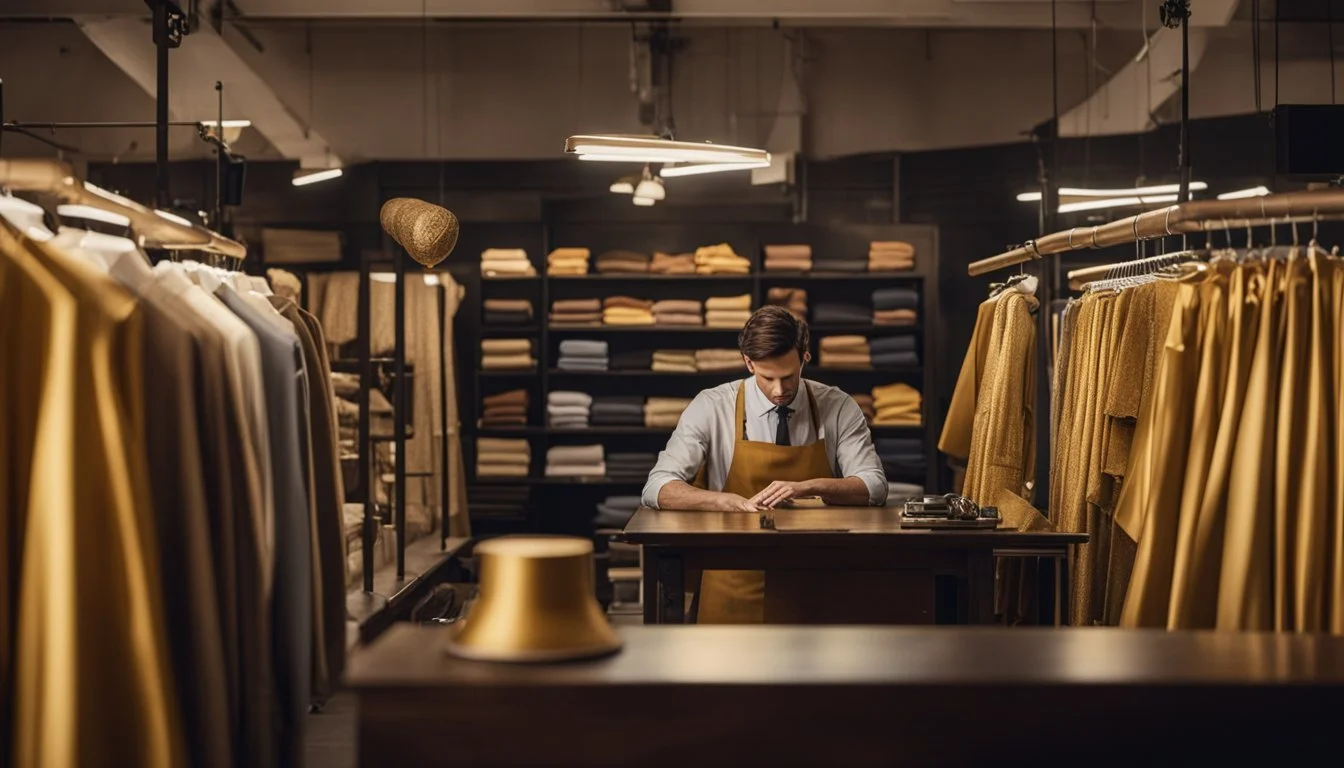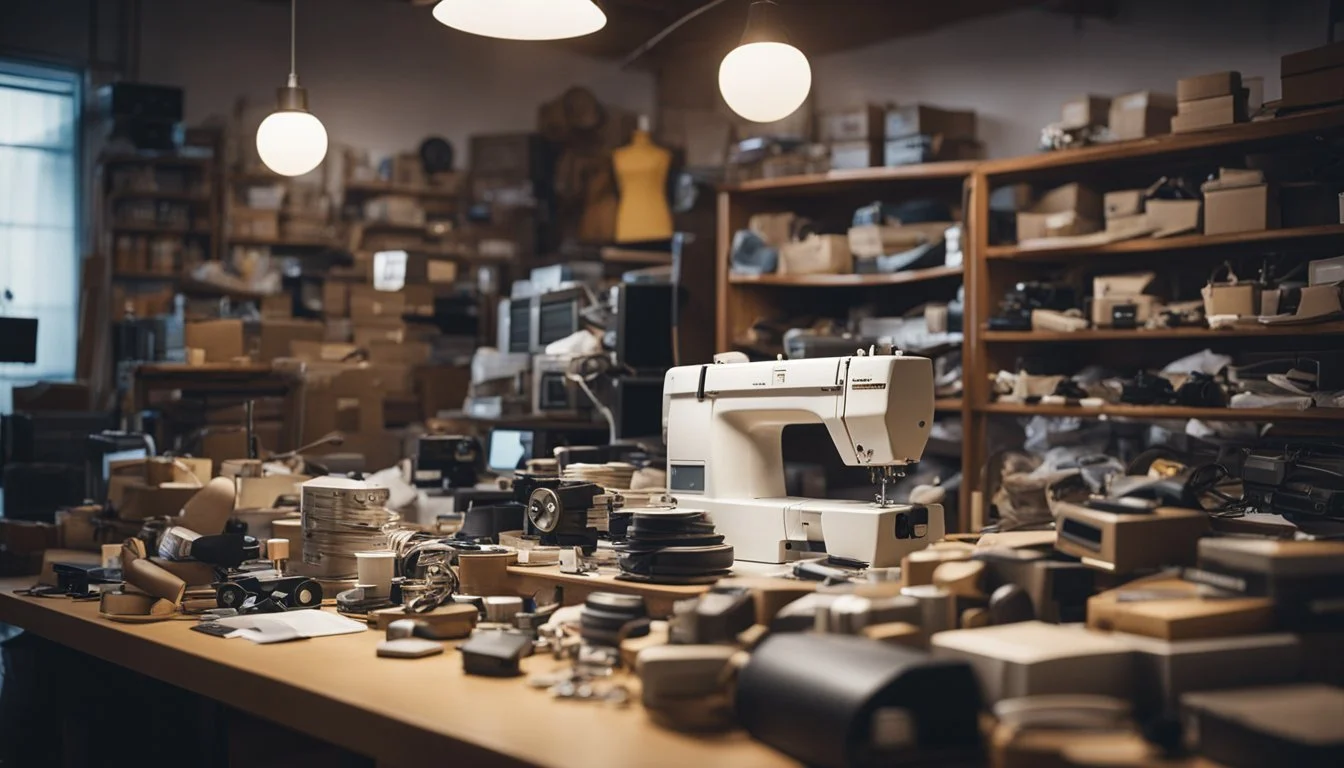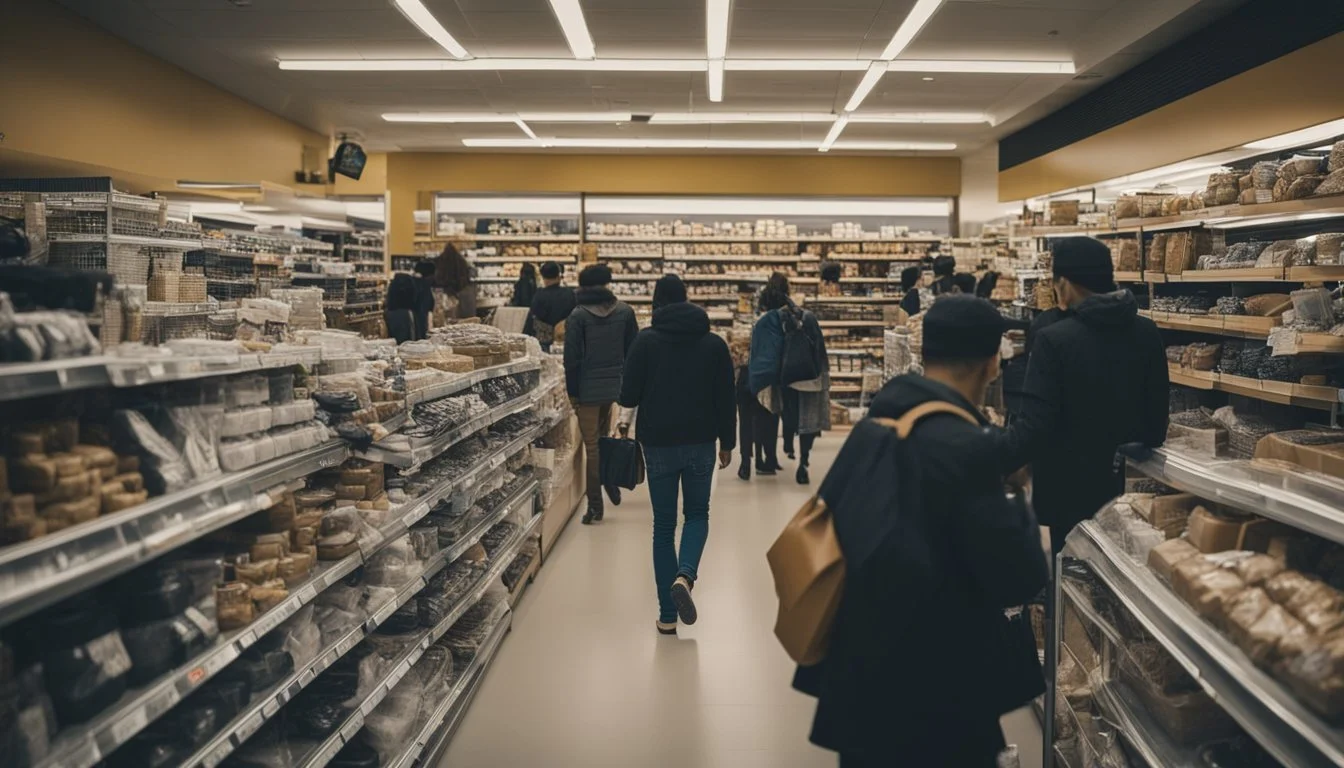8 True Crime Documentaries About Counterfeiting in Retail
Exploring Fake Goods and Fraudulent Schemes
In recent years, the retail industry has faced significant challenges due to the rise of counterfeit goods. Counterfeiting not only affects the profits of legitimate businesses but also poses risks to consumers, who often unknowingly purchase fake products. Documentaries on this topic provide an in-depth look at the complex world of counterfeiting, shedding light on the methods used by counterfeiters and the efforts by authorities to combat this illegal trade.
These true crime documentaries offer valuable insights into the hidden mechanisms of retail counterfeiting, making them essential viewing for anyone interested in the darker side of the retail industry. By exploring real-life cases and showcasing the impact on businesses and individuals, these films highlight the ongoing struggle against counterfeit goods in the global market.
1) Fake Gold: The Tailor's Scandal (2023)
"Fake Gold: The Tailor's Scandal" is a gripping true crime documentary released in 2023. The film centers around a tailor named Giovanni Russo, a seemingly respectable businessman who orchestrated a large-scale gold counterfeiting scheme.
Russo's scandal rocked a small Italian town. He used his tailor shop as a front to produce fake gold bars and jewelry. These counterfeit items were sold to unsuspecting customers and local jewelers.
Law enforcement took years to uncover the operation. Investigators faced challenges due to the high-quality forgeries that were nearly indistinguishable from real gold. The documentary provides insight into the meticulous process used by Russo to create the counterfeit gold.
The narrative includes interviews with victims, law enforcement, and forensic experts who helped bring Russo to justice. It offers a detailed look at the impact of counterfeiting on consumers and local businesses.
For those interested in the mechanics of counterfeiting and its real-world implications, "Fake Gold: The Tailor's Scandal" is a must-watch.
2) Counterfeit Craze: Retailers Fight Back
Retailers face a persistent challenge from counterfeit goods infiltrating their stores. The rise of e-commerce has exacerbated the issue, making it imperative for companies to adopt robust anti-counterfeiting measures.
Many retailers are investing in advanced technology to detect and combat counterfeit items. This includes using blockchain to verify product authenticity and employing AI-powered tools for better oversight.
In addition to technology, collaboration is key. Retailers often work with law enforcement agencies and government bodies to coordinate raids and crackdowns on counterfeit supply chains.
Examples include police-like investigation centers within stores aimed at catching counterfeit rings. Retailers are also increasing training for staff to identify fake products more effectively.
Public awareness campaigns help educate consumers on spotting counterfeit items. This assists in reducing demand and discourages the purchase of fake goods.
Retailers are also pushing for more stringent legal measures. They advocate for stronger penalties for counterfeiters and seek to close loopholes that allow fake goods to enter the market.
Enhanced return policies play a role in this fight. By making it easier for customers to return counterfeit items, retailers can identify and remove these products from circulation quicker.
These measures, combined, illustrate a comprehensive approach to tackling the counterfeit craze in retail, ensuring both retailers and consumers are better protected.
For more information, you can refer to:
3) Shoddy Sneakers: A Mass Deception
Counterfeit sneakers have become a significant issue in the retail industry. With the rise of online marketplaces, the distribution of fake sneakers has grown exponentially. This segment explores the implications of counterfeit shoes on the retail market.
The global sneaker market is worth billions, making it a lucrative target for counterfeiters. Fake sneakers often mimic high-end brands, deceiving customers into thinking they are purchasing genuine products.
These counterfeit sneakers are typically made from inferior materials, leading to issues with durability and comfort. The unauthorized use of brand trademarks also impacts the reputation and economic stability of affected companies.
One notable case involved the dismantling of a large counterfeit sneaker ring, where thousands of fake shoes were seized. These operations often span multiple countries, complicating enforcement and legal actions.
Consumers who unknowingly purchase counterfeit sneakers face significant financial loss and disappointment when the product fails to meet expectations. Educating buyers on how to identify genuine products is crucial in combating this issue.
For more information on the topic, readers can explore resources such as the Wikipedia article on counterfeit goods.
4) Faking Fashion: The High-End Knockoffs
Counterfeiting in the fashion industry is a significant issue, affecting both luxury brands and the economy. High-end knockoffs replicate expensive designer goods, making them accessible at a fraction of the cost. This section examines documentaries revealing the dark side of these counterfeit operations.
1. The True Cost (2015): This documentary addresses the impact of fast fashion and counterfeits on the global economy and environment. It explores how the desire for cheap knockoffs contributes to labor exploitation and environmental degradation. The True Cost (2015)
2. Fake: Searching for Truth in the Age of Counterfeit Goods (2019): This film delves into the economic and social consequences of counterfeit fashion. It shows how counterfeit goods can fund illegal activities and impact legitimate businesses. Fake: Searching for Truth in the Age of Counterfeit Goods (2019)
3. Counterfeit Culture (2013): This documentary investigates the global trade in counterfeit goods, focusing on fake luxury items. It highlights the sophisticated methods used by counterfeiters and the challenges faced by brands in combating these fakes. Counterfeit Culture (2013)
4. True-Cost Fakes: Inside the World of High-End Counterfeiting (2020): This film explores the intricate world of luxury item counterfeiting, shedding light on the production and distribution networks. It provides a comprehensive look at how these counterfeit goods are made and sold. True-Cost Fakes: Inside the World of High-End Counterfeiting (2020)
Counterfeit fashion not only deceives consumers but also funds criminal activities, including terrorism and organized crime. Documentaries in this genre provide enlightening insights into this shadowy world, helping viewers understand the broader implications of counterfeit luxury goods.
5) Bogus Bills: Secret Service Investigations
The United States Secret Service plays a crucial role in combatting counterfeit currency.
With the evolution of scanning and printing technology, the challenge of identifying and intercepting fake bills has grown. The Secret Service employs advanced forensic techniques to track and dismantle counterfeiting rings. These investigations often reveal the ingenuity and audacity of counterfeiters.
Documentaries featuring Secret Service operations delve into cases where agents meticulously piece together clues. They demonstrate the technological advancements both in counterfeiting and in the measures to prevent it.
One notable example is the investigation of the notorious counterfeiter who forged the 1996-series $100 bill and later the 2013 "blue note." This case highlighted both the persistence of counterfeiters and the relentless efforts of the Secret Service to bring them to justice.
The documentarians showcase how these investigations not only protect the financial system but also dismantle entire networks involved in illegal activities. Each case serves as a testament to the intricate and high-stakes nature of counterfeiting investigations.
6) Phony Phones: Tech's Counterfeit Culture
Counterfeit electronics, particularly smartphones, have plagued the tech industry for years. These fake devices, often produced in large unregulated factories, mimic genuine brands but lack the quality and safety of authentic products.
"Planet Money: How the FBI's Fake Cell Phone Company Put..." (2024) dives into the FBI's covert operation where agents ran a sham smartphone company to infiltrate drug smuggling networks. This operation revealed the broader impacts of counterfeit phones on security and market integrity. More information.
Counterfeit Culture (2013) exposes the hazards of counterfeit goods, from electronics to pharmaceuticals. This documentary underscores the dangers posed by fake tech products, highlighting the global scale of the problem. More information.
Fake electronics, including smartphones, often incorporate inferior components, leading to device malfunctions and potential safety hazards. The replication of branded devices undermines consumer trust and distorts market dynamics.
Governments and tech companies continuously battle counterfeiters through legal action, awareness campaigns, and advanced technology. Despite these efforts, counterfeit tech products persist, driven by high demand and lucrative profit margins.
7) Fraudulent Fragrances: Scent of a Scam
The world of fragrances is not immune to counterfeiting. Fraudulent fragrances are a significant problem in retail, often involving the production and sale of fake perfumes that mimic luxury brands.
These counterfeit products can be difficult to distinguish from authentic ones, presenting a serious issue for both consumers and manufacturers.
Counterfeit fragrances can pose health risks due to unregulated and potentially harmful ingredients. They are often sold through unauthorized retail channels, including online marketplaces, street vendors, and unauthorized discount shops.
Consumers might think they are getting a great deal, but they are often paying for substandard and unsafe products.
The documentary "Perfume: The Story of a Murderer" (2006) explores themes of fragrances and obsession, although it is a fictional story. It provides some insight into the cultural significance of scents, albeit in a dramatized form.
For those interested in real-life cases, "Counterfeit Culture" (2013) touches upon the broader topic of counterfeit goods, including fragrances. The film delves into how these illicit products are made and distributed, highlighting the far-reaching impact of this illegal trade.
External links:
8) Duped: The Art of Shoplifting and Counterfeits
This documentary focuses on the widespread issues of shoplifting and counterfeiting in the retail industry. It explores how these illegal activities carry significant financial repercussions for businesses and consumers alike.
Through a series of interviews and undercover footage, viewers gain insight into the tactics employed by both small-time thieves and organized counterfeit rings.
The film reveals the sophisticated methods used to produce and distribute counterfeit goods in the retail market.
"Duped: The Art of Shoplifting and Counterfeits" highlights the collaborative efforts of law enforcement and retail security experts to combat these crimes.
The documentary sheds light on the impact of technology and social media in facilitating and detecting shoplifting and counterfeit operations.
Released in 2024, it provides a comprehensive look at the ongoing battle against retail theft and fraud.
Understanding Counterfeiting in Retail
Counterfeiting in retail involves the production and distribution of imitation goods that are sold as genuine. It impacts the economy and consumer trust, with a significant portion of retail markets affected by these deceptive practices.
Definition and Scope
Counterfeiting in retail refers to the creation of fake or imitation products designed to deceive consumers into believing they are purchasing genuine items. These counterfeit items often replicate branding, packaging, and the overall appearance of authentic products. This illegal activity spans a wide range of goods, from luxury items to everyday consumer products, affecting the global market significantly. The scope includes not only physical stores but also online marketplaces, where identifying counterfeit products can be especially challenging for consumers.
History of Retail Counterfeiting
Retail counterfeiting has a long history, dating back to ancient commerce. The replication of currency and goods has been documented across various cultures and epochs. Historically, counterfeiters have targeted high-value items like currency, art, and luxury goods. With the advent of mass production and global supply chains, the practice has expanded and become more sophisticated. Advances in technology have made it easier for counterfeiters to produce convincing replicas, making it a persistent issue in both physical and digital retail spaces.
Commonly Counterfeited Goods
The range of commonly counterfeited goods is vast. Luxury goods such as branded clothing, handbags, and watches are frequently targeted due to their high retail value. Electronics like smartphones and accessories are also popular among counterfeiters. Pharmaceuticals represent a particularly dangerous category, as counterfeit medications can pose serious health risks. Beauty products, toys, and automotive parts are also commonly counterfeited, impacting consumer safety and brand integrity. Understanding these categories helps consumers and policymakers identify and combat counterfeit activities effectively.
Impact of Counterfeiting on the Retail Industry
Counterfeiting in retail not only leads to substantial financial losses but also damages brand reputation and erodes consumer trust. Each of these factors has significant implications for businesses and their long-term sustainability.
Financial Losses
Retailers face significant financial challenges due to counterfeiting. Estimates suggest that counterfeit goods account for between $1.7 trillion to $4.5 trillion in sales annually. These losses are not just due to direct sales of counterfeit items, but also involve costs related to combating counterfeiting, such as legal fees and enhanced security measures. Jobs are also at risk, with millions of legitimate positions potentially lost due to counterfeit activity. The financial drain extends to potential investment losses, as companies may become less attractive to investors wary of the impact of counterfeiting on profit margins.
Brand Reputation Damage
Brand reputation suffers greatly when counterfeit products infiltrate the market. Consumers often cannot distinguish genuine products from fakes, and poor experiences with counterfeits can lead to negative perceptions of the brand. This damage is particularly severe in industries like luxury goods, where brand value is a key asset. Companies spend years building trust and loyalty with their customers, only to see it undermined by counterfeit products that offer inferior quality and can even be harmful. This situation necessitates significant spending on public relations and brand management to rebuild tarnished reputations.
Consumer Trust Erosion
Consumer trust is a critical component of a successful retail operation, and counterfeiting directly undermines this trust. When consumers purchase counterfeit items believing them to be genuine, their dissatisfaction can lead to reduced confidence in the brand. This erosion of trust affects not only the purchasing decisions of individual consumers but can also spread through word-of-mouth and social media, amplifying the negative impact. Retailers thus face the dual challenge of reclaiming trust while preventing counterfeit goods from reaching the market in the first place, a task that often involves legal and logistical hurdles.
Measures to Combat Counterfeiting in Retail
Combating counterfeiting in retail involves a multifaceted approach. Retailers employ technological solutions, legal and regulatory actions, and both retailer and consumer education to address this pervasive issue.
Technological Solutions
Retailers implement advanced technologies to detect and prevent counterfeit goods. RFID tags help track products through the supply chain, ensuring authenticity. Holograms and watermarks provide visual verification that products are genuine.
Blockchain technology is utilized for creating secure, transparent records of product origins. AI and machine learning can analyze patterns and detect counterfeit listings on e-commerce platforms. These technologies collectively enhance traceability, making it difficult for counterfeits to penetrate legitimate markets.
Legal and Regulatory Actions
Governments play a critical role in combating counterfeiting through stringent laws and regulations. The INFORM Consumers Act exemplifies legislative efforts to curb retail crime by increasing accountability of online marketplaces.
Enforcement agencies, like the Department of Homeland Security, conduct large-scale operations to seize counterfeit goods. International cooperation among countries also strengthens efforts, as counterfeiting is a global issue. Stiffer penalties and swift judicial proceedings help deter counterfeiters.
Retailer and Consumer Education
Educating both retailers and consumers is essential to reducing counterfeits. Retailers train employees to recognize counterfeit signs and to implement verification processes. They also educate their supply chains to maintain high standards of integrity.
Consumers are informed about how to identify fake products through campaigns and tutorials. Brands may use dedicated websites and customer hotlines to report suspected counterfeit items. When consumers are vigilant and knowledgeable, they become a powerful ally in the fight against counterfeit goods.




